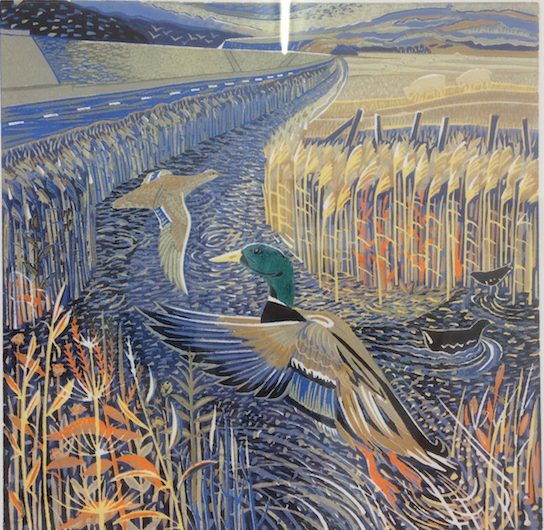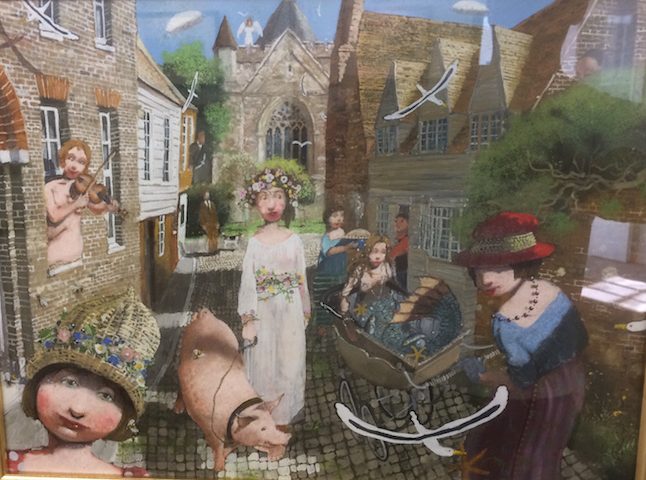Titles can be misleading as Richard Adams’ chalk pastel above entitled Normal for Rye has a pig being herded along West Street towards Lamb House while a violin playing nude leans out from a window. Readers familiar with EF Benson’s Mapp and Lucia novels and the recent “Mapp” BBC TV series may think it accurately reflects life in Rye, but residents in the historic citadel – topped by St Mary’s Church, seen in the painting’s background – may disagree.
This is just one of nearly 400 exhibits by more than 100 artists in Rye Society of Artists Summer Exhibition in the Dance Hall behind the Community Centre in Conduit Hill until August 27 from 10:30am to 5:30pm daily – and even that title may also be misleading if you think “artists” are just painters.
This selling exhibition by local artists features a wide range of both one-dimensional artistry (such as paintings and drawings) and three-dimensional works of art, including ceramics and sculpture, displayed on walls, tables and windowsills on two floors and a staircase, so Rye Society of Artists is a very wide-ranging title. So also are the subjects covered in the exhibits, but Rye has attracted artists over the centuries because of its landscape – the sea, the beaches and the marshes – and it is not surprising therefore that the local landscape features heavily as subject matter.


“Collision Course” by Andrew Blyth
( left) is one of five watercolours he has submitted and, while there seems to be no limit on the number of ceramic items submitted, the one-dimensional artists appear to have a limit of six paintings or drawings.
Sea Scape (above right) is a mixed media offering from Val Falla, and it has a red dot beside it meaning it has been bought – and there are a growing number of red dots around the exhibits. Buyers should remember however that they will have to get their purchase home and also have a safe place to put it. I therefore generally avoid vulnerable ceramics.
A statue of a naked artist’s model, called AJ and created by my second wife, has been bounced twice – by a furniture remover and a passing grandchild – and is held together by black duct tape (which is the same shade as the statue) and hanging wire (which attaches it firmly to the adjacent book case).
However I once bought a very large oil painting on New Year’s Eve in St Ives, forgetting I was travelling back to Camden Town in London that night. The train however was, thank goodness, virtually empty. And Val’s painting above is comparatively small and I have a space earmarked for it.
As the exhibition shows, “painting” can take many forms and a mixed-media collage is just one. Images can be recorded in a variety of ways using different media and can also be reproduced in a variety of ways on a range of surfaces. These varieties include acrylics, oils, charcoal, ink, pastels and watercolours, etchings, linocuts, silkscreens, woodcuts and photographic prints, on paper, board and textiles (all represented in this exhibition) and I am sure there are others I have overlooked.
Matt Hardman’s “Stephen” (below) was listed as “multi media with glitter, beads, and badger teeth” and is clearly a very different approach from Richard Adams’ chalk pastel (at the top above).


Quite a few of the names and styles will be familiar to those who have attended previous exhibitions – as may some of the subject matter.
Annie Soudain’s “In Pursuit” (pictured right) is a reduction linoprint and looks suspiciously like a view on Pett Level – and I would have red-spotted it had an early bird not got there first and snapped it up. But, as a print, it may well pop up elsewhere, possibly in Rye Art Gallery!
Louis Turpin’s oil painting (below) entitled “Morning Frost at Great Dixter” is more abstract and cubist than his naturalistic sheep which I have seen before, and I am afraid Great Dixter’s topiary garden of sculptured trees and bushes does not have such straight lines.
There is masses to see, though, at Great Dixter, of topiary and other plants, as it is mid-summer (especially for families visiting).

Turning from the flat single dimension paintings to the 3D “ceramics” there was again a whole mixture of materials and processes, ranging from Portland Stone, clay, glass and slate to rusted iron and driftwood (and other “found objects”) enhanced with transfers, glazes and collages, as well as the more obvious products of the potter’s wheel.
Bernard McGuigan’s “Mother & child” in Portland Stone (below left) was one of the more traditional pieces while “Denge Crank” by Annabel Faraday (below right) featuring printed stoneware and rusted ironwork and included a lot of information while at the same time (I thought) captured a feeling of our local marshes, and Dungeness in particular.
However it was too large for my art-encrusted home, cunningly designed now as a no-go area for young children.


The examples above are just a very few of the around 400 exhibits, but they demonstrate the vast range of what is on show – and was often clearly inspired by Rye, its surroundings, and its history – as well as its literature, and the writers who have also lived here.

It seems appropriate to end therefore with an oil painting of Camber Beach (though an RNLI 4×4 packed with Aussie lifesavers is missing) on the right as it reminds me of the St Ives painting I still have, which I only just squeezed diagonally into the back of a London cab on that New Year’s Eve.
The exhibition continues until August 27 and has a tiny admission charge (think pennies). It is on two floors though and there is no lift – just steepish stairs. And on the morning of August 28 you can watch the buyers departing with their loot.
Photos of exhibits: Kevin McCarthy




Good write-up, but a one-dimensional painting would be of little interest, being a straight line! I think you meant two-dimensional.